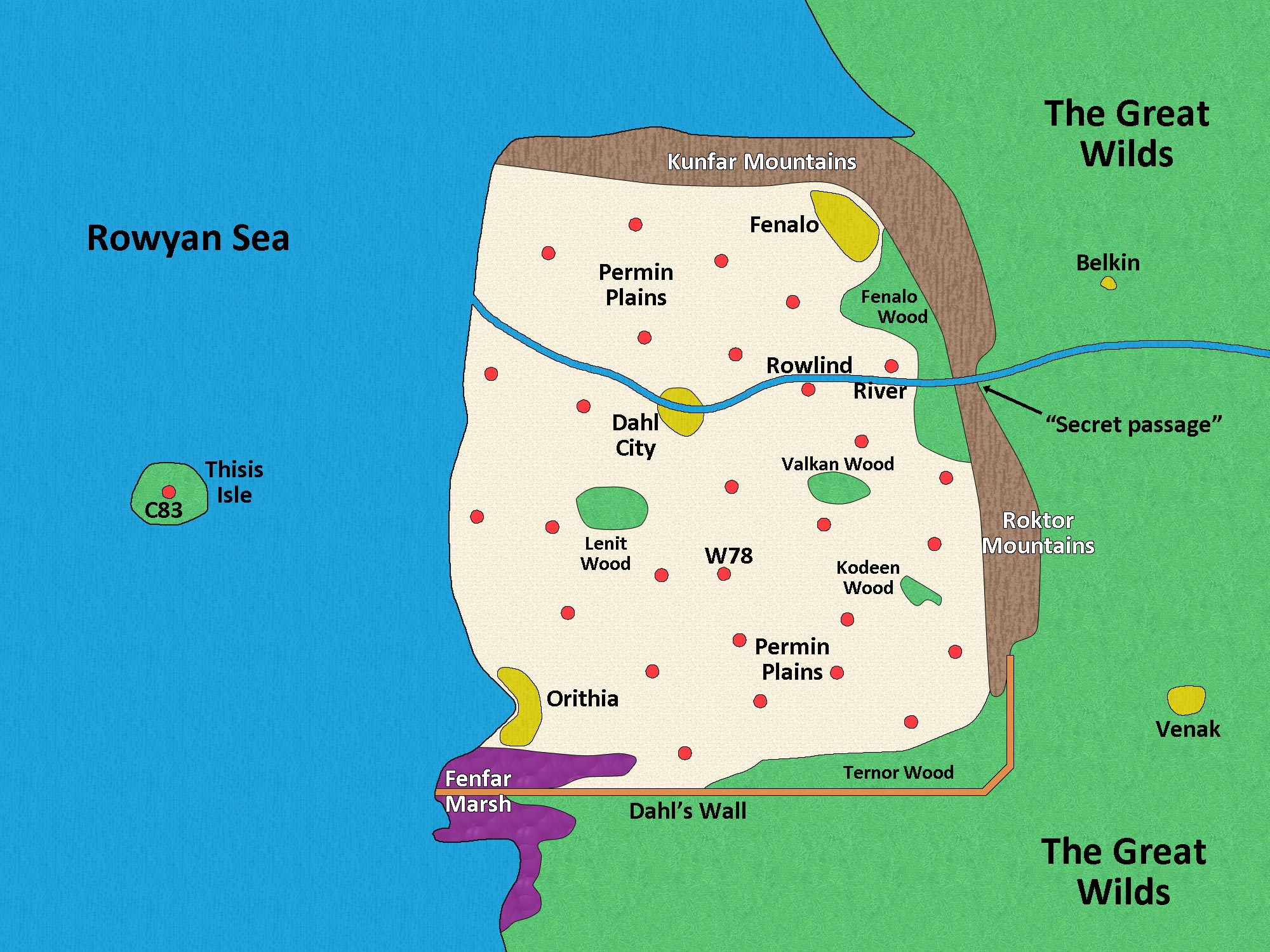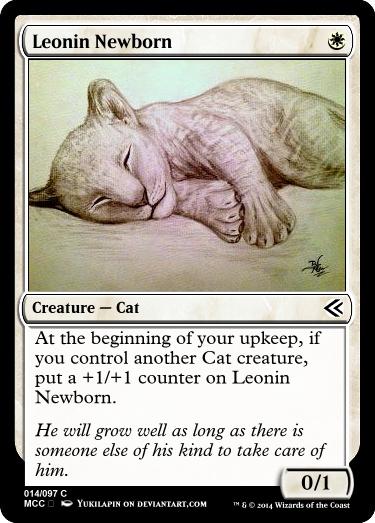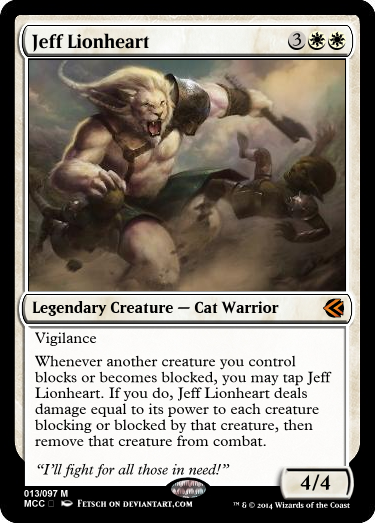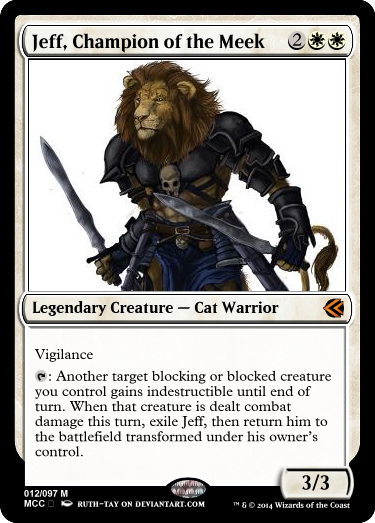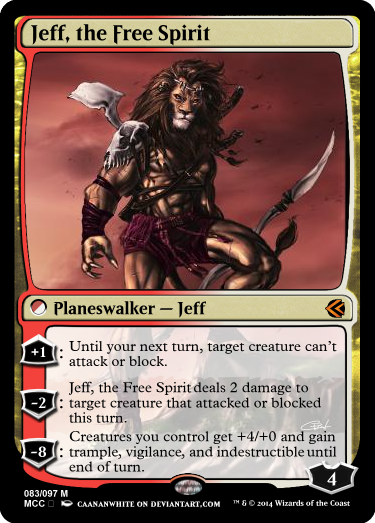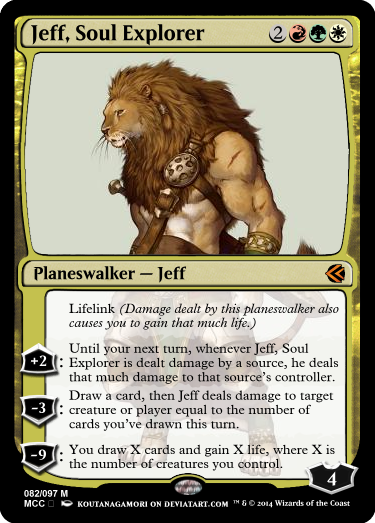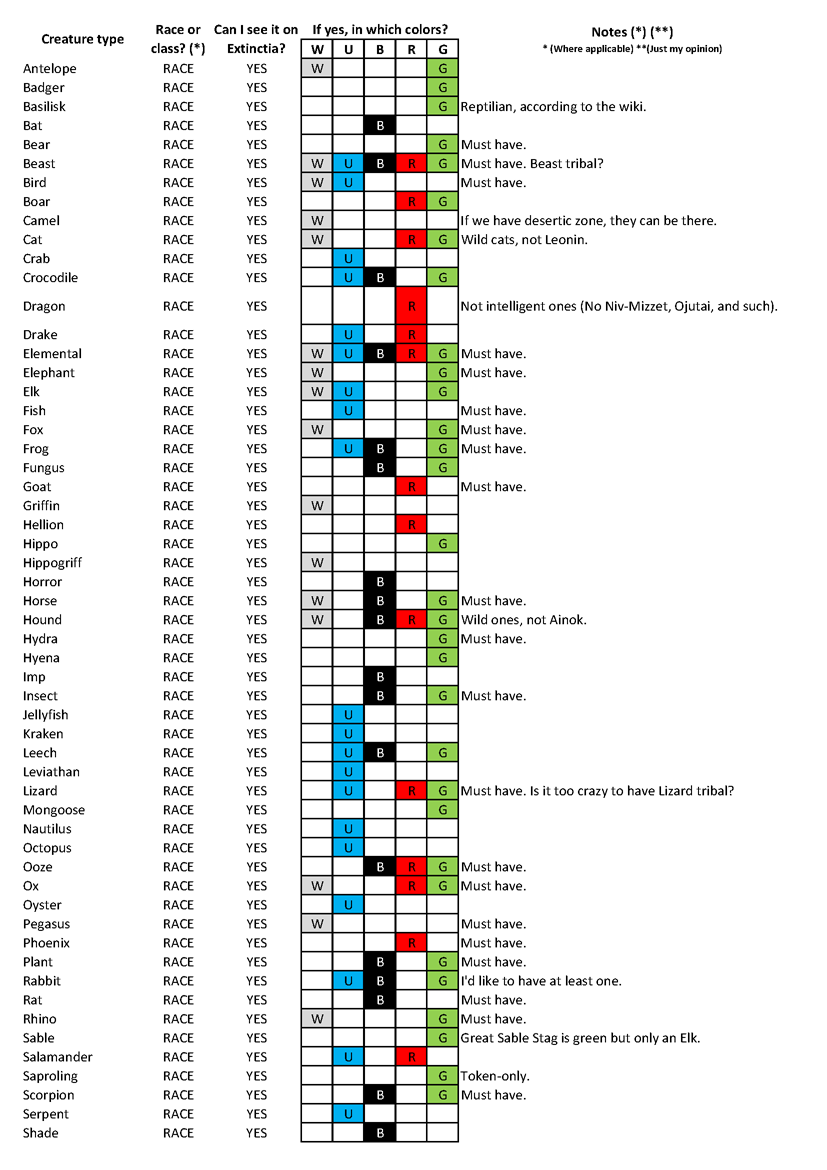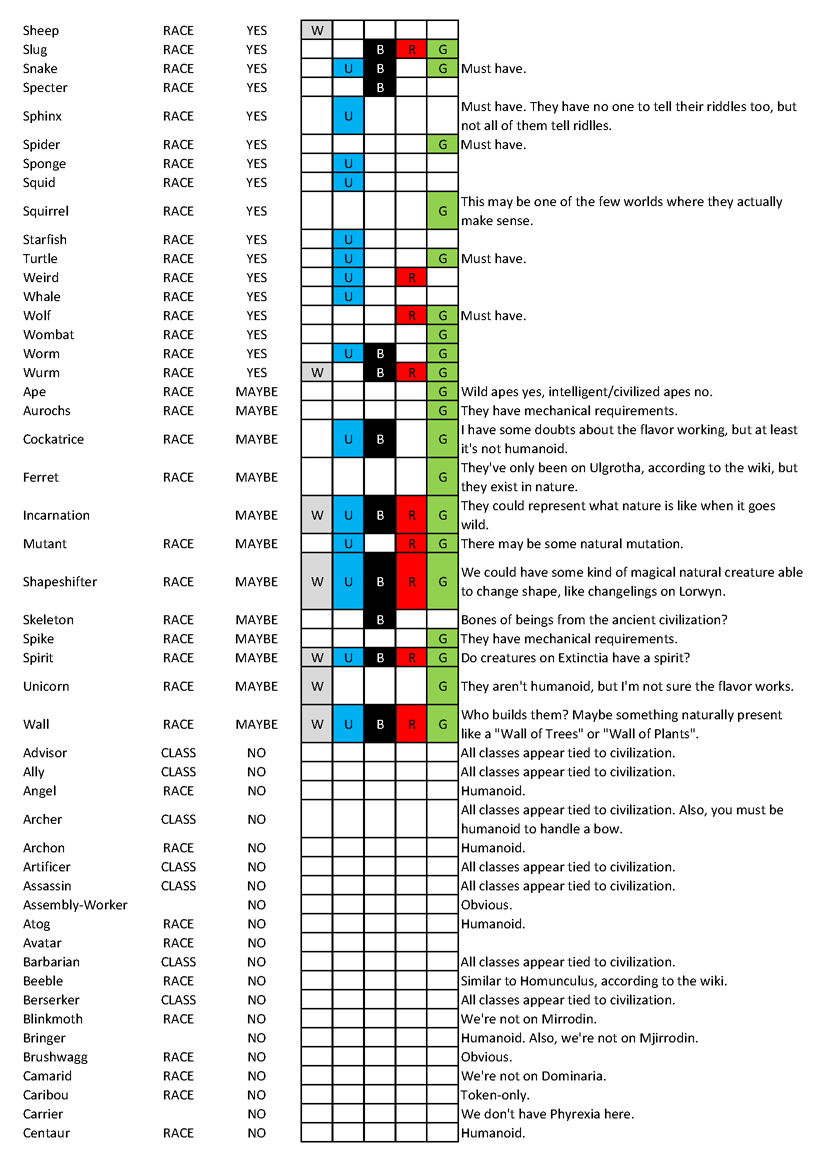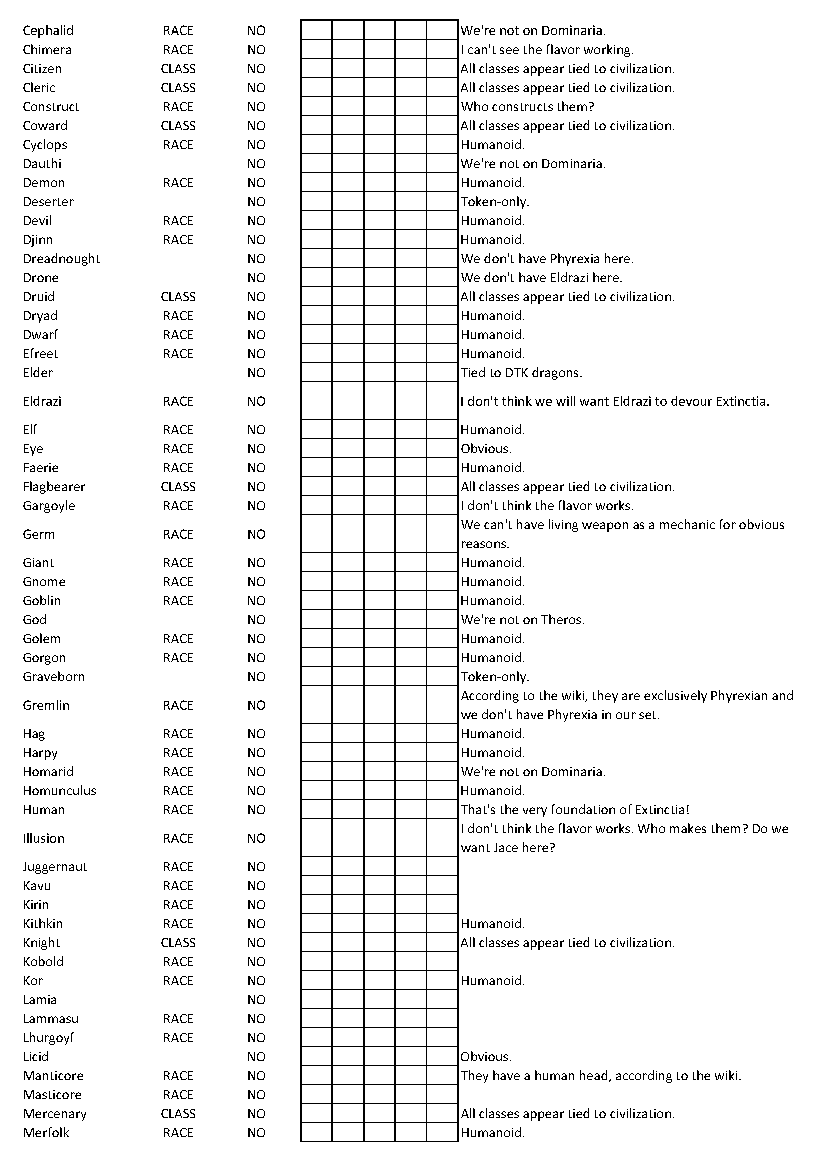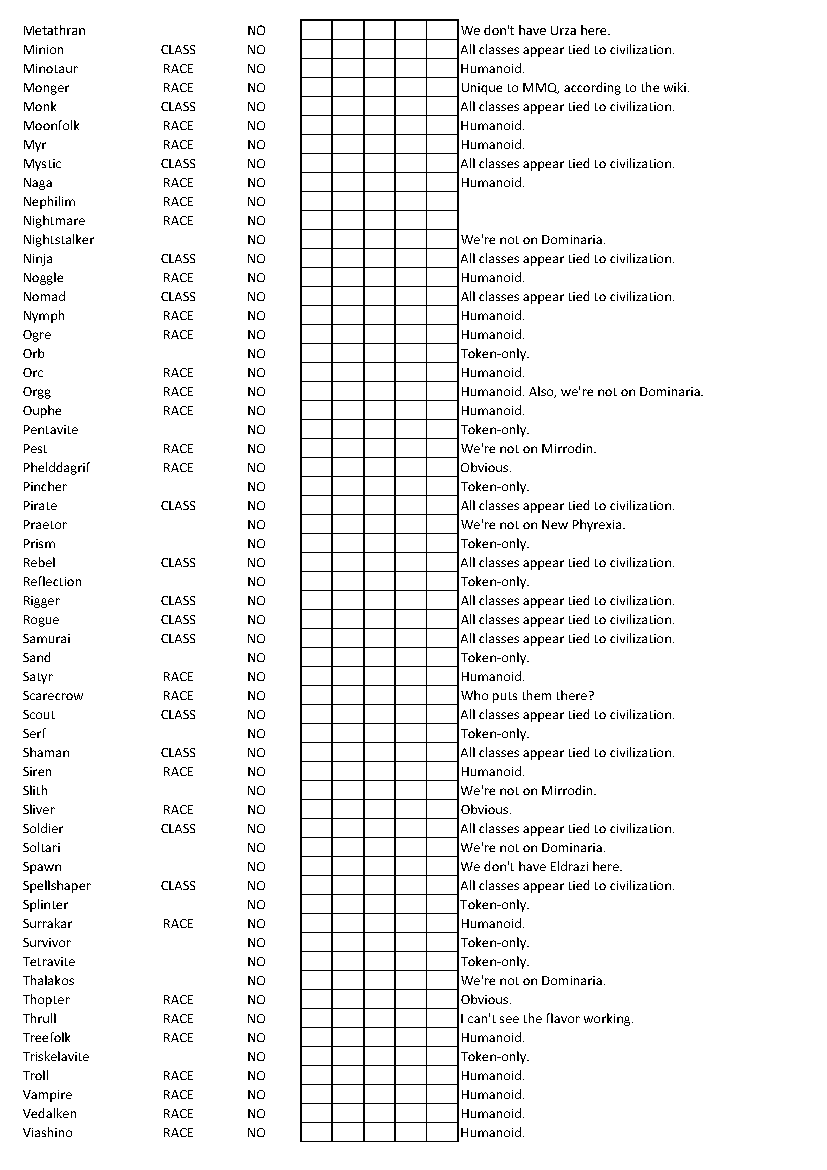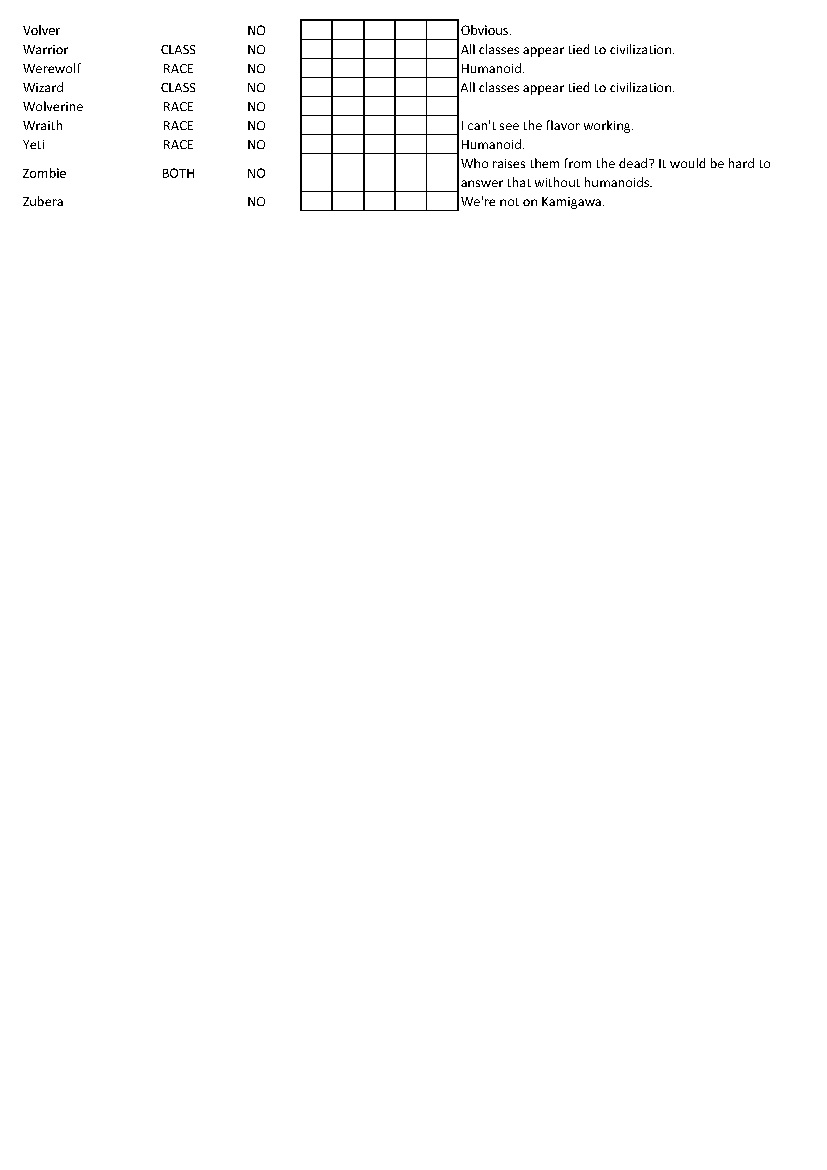
(The banner is my own elaboration. The original image is by Holly Chaffin and is released in the public domain.)
The Lion's Lair #12
"Magic grammar"
The article index is always updated with the latest content.
First of all, thanks to Aspirinsmurf who unwillingly inspired this article just by participating in the DCC and designing this card, which you can see me and Flatline talking about in the discussion thread. There is a problem with that card that I'm going to talk about later in the article, but an even bigger problem is that I'm seeing such mistakes done a huge amount of times, way too often and by a lot of different people. What kind of mistakes I'm talking about? Simple: pieces of rules text or reminder text that are good and perfectly acceptable in English, but at the same time are wrong and not acceptable in Magic. This kind of mistakes is particularly subtle, as they rightly don't even sound wrong to the average English speaker.
Back to school
Suppose you're learning a new foreign language that you only know one thing about: it uses the same alphabet as English. In my case, that language could be German. What are the key basic components you have to learn to start speaking that language so completely unknown to you? I can think of three: pronunciation, some vocabulary, and grammar. Magic rules text is kind of its own language, separate from English, Italian, or all other languages Magic cards are printed in. In fact, sometimes technical Magic text is even referred to as "Magic-ese", which is an expression I personally hate but gives a good idea of what I'm talking about. I'll just call it "Magic language" instead. So, how do the English and Magic languages compare in those three categories I mentioned above?
• Pronunciation is obviously the same, so no problem there.
• Vocabulary can already bring some troubles, as there are words which meaning is different in Magic compared to their ordinary English one. That's one of the reasons R&D doesn't want to keyword "milling" (which means "put some cards from the top of a player's library into his or her graveyard" for those who might not know), "bounce" (returning permanents to their owners' hands), and such. I think I might write another article in the future about Magic vocabulary, but that's not what I want to talk about today.
• Grammar is by far the worst comparison. There are a few rules of English grammar that rules text doesn't respect (and cannot do so even if you'd want) and many more specific rules of the Magic language's grammar it has to respect. Practically, Magic rules text has to obey to two grammar systems at the same time. You can imagine this as different layers in an image, for those that know Photoshop or similar programs. You have your raw text at the bottom with two layers of grammar applied over it: the lowest one is ordinary English grammar, and the topmost one is Magic grammar. A structure like the following:
---MAGIC GRAMMAR---
---ENGLISH GRAMMAR---
---RAW TEXT---
You're observing (or reading) from the top, don't forget that! Just like with an image in Photoshop, what you see (or read) is the overlap of all the levels. That is the final result. That must be the final result. Well, unless you don't care about the quality of your custom cards, but if that's the case, what are you doing here? 
Apples, oranges, and Schroedinger's cat
The problem lies where those two layers of grammar are telling you different things. So now let's see some examples.
1) "Whenever... would... instead..."
This is the mistake in the card by Aspirinsmurf I linked at the beginning of this article. Let's look at its rules text again:
Whenever you would draw a card, you may instead have Ignorant Brute deal 2 damage to target creature or player.
This sentence is perfect in English, but wrong in Magic. That's because of the special meaning that three words have in the Magic language, that imposes additional rules on where to use or not to use them. These three words are "when", "whenever", and "at". Their special Magic meaning is to identify triggered abilities. If an ability starts with one of them, it is by definition a triggered ability. So you can only use them when the ability they're used in is actually a triggered ability.
Now, one could say: "then it will just mean this is a triggered ability", except it's not. Why can't that be a triggered ability? Because there are other two words that have additional baggage in Magic grammar: "would" and "instead". These two words identify a replacement effect, which is an effect that substitutes a particular event (specified by the "would" part) that never happens with another event (specified by the "instead" part) that happens in its place. Not all replacement effects are worded like this, but most are. Those that are not don't invalidate this point anyway. Replacement effects are a kind of static ability, so that can't also be a triggered ability at the same time, as the word "whenever" at the beginning wants it to be. The result is an ability that is half a triggered ability and half a replacement effect. If you allow me to use an example from my field of study (chemistry), you have the "Schroedinger's cat" of Magic abilities: it's both a triggered ability and a replacement effect at the same time, just like that cat can be dead or alive at the same time, or an electron can be both a wave and a particle at the same time! But the foundations of quantum mechanics have nothing to do with Magic mechanics, and what is acceptable there is not in Magic. No ambiguities are allowed in our favorite game!
So how should a replacement effect of the kind Ignorant Brute wants to have be worded? The solution is very simple: change "whenever", that has unwanted baggage in Magic grammar, with "if", that doesn't change the English meaning of the sentence and doesn't have that rules baggage (it has other rules attached though, namely the "intervening if clause", but that's another matter).
Use "if... would... instead..." for your replacement effects and nobody gets hurt! Ignorant Brute should say:
If you would draw a card, you may instead have Ignorant Brute deal 2 damage to target creature or player.
But that's not the only mistake in that card. Let's see another Magic grammar rule, which this time stems from logic.
2) If you replace an event with something you "may" do, you must always specify what happens if you don't! Remember: the original event (the "would" one) doesn't exist anymore!
Let's say, for example, that you have a basket with one apple in it that can't be empty for whatever reason. You remove the apple, then "you may" put an orange in the basket. Let's make both cases. Let's first suppose you choose to put the orange in the basket: you end up with an orange in the basket, so the basket is not empty and you're fine. But let's consider now what happens if you choose to not put the orange in the basket. You end up with an empty basket, because the apple is no longer there: you've already removed it! So now the basket is empty, and you have a contradiction: at the beginning we said it can't ever be empty. Change the "basket" with a "replacement effect", the apple with the "would" event that no longer exists, and the orange with the new "instead" event that happens in its place, and you have the equivalent of that contradiction in Magic. And again, we don't want contradictions in our favorite game!
Do you want a real example of such a kind of replacement effect done right? Just look at one of the game's most infamous mechanics: dredge! Let's look at its reminder text:
Dredge N (If you would draw a card, instead you may put exactly N cards from the top of your library into your graveyard. If you do, return this card from your graveyard to your hand. Otherwise, draw a card.)
Have you ever wondered where the underlined part comes from? One could say: "but you were drawing that card anyway!", but that's not true, as the "would" part of the replacement effect has already erased that draw. You've already removed the apple from the basket! You can't say the apple is still in! If you want the basket to be always full you have to say "you may put the orange in, but if you don't put the apple back in"! The equivalent of putting the apple back in is the underlined part of dredge, and that's why it's necessary.
So, at this point, now that we've explored this aspect too, how should have Ignorant Brute been worded?
If you would draw a card, you may instead have Ignorant Brute deal 2 damage to target creature or player. If you don't, draw a card.
But it's not over!
3) Static abilities (and replacement effect as part of those) CANNOT target.
In all of the above I've been ignoring the "target" part, which is also wrong. The word "target" is another of those words that have attached baggage in the rules. It's probably the single word with the heaviest baggage attached, so you should pay attention to where it does or does not belong.
Choosing targets is part of the procedure called "casting a spell". It's one of the earliest parts actually, but what I want to notice here is that it's a word that is part of the process that puts a card on the stack, waiting to resolve. Only things (spells or abilities) that use the stack can target! Don't underestimate this aspect: it's huge. Non-exhaustive list of notable things that do NOT use the stack, and thus CANNOT target:
• Static abilities (which replacement effects are part of) do not use the stack, because they are always active anyway, so they can't target.
• Special actions, like morph and its variants (manifest and megamorph). Turning a morph or a manifested creature face up is a special action that can be done at any time and cannot target. Triggered "when this is turned face up" abilities can target though, as they are, well, triggered. Beware of not confusing those two things!
• Playing a land. Lands aren't spells (no, not even Dryad Arbor is a spell) and thus they can't target when played. Again, landfall abilities that trigger on you playing a land can target though, and you don't have to confuse them!
Note that "choosing" something is different from "targeting" it. What the above can't do is target things, not have you choose things. What is the difference? Targeting happens while the spell is being cast, while choosing happens only much later, when the spell resolves. The same goes for abilities.
So we said that Ignorant Brute's ability can't target because it's a replacement effect. How can we fix it? At the low cost of a very small functional change, that many players won't even notice nor understand, you can turn targeting into choosing and you're good to go!
If you would draw a card, you may choose a creature or player instead. If you do, Ignorant Brute deals 2 damage to that creature or player. If you don't, draw a card.
Now we finally have a functionally working version of the Brute's ability. Phew, that was long... but hopefully now you understand it. But that is not the only custom card that catched my attention recently...
4) "As" vs "when"
I've already talked about this in my "Mark of Quality" articles, but a card I recently judged in the MCC gave me inspiration to also include it here. The card in question was by Marco and had the following new custom keyword:
Ambition 1 (As this creature enters the battlefield, put the top card of your library into your graveyard and put a +1/+1 counter on it for each creature card put into your graveyard this way.)
This ability doesn't work as is, and that's because of the specific Magic meaning of the word "as", which again is way more specific than its ordinary English meaning, and that's the trap!
First, a premise: this, like the dredge example before, is reminder text, and that has no rules meaning, so it's allowed to be looser and less precise than rules text. It's even allowed to make lands continue to burn! (Man, how I hate that card just because of that reminder text...) The problem comes when the reminder text is functionally different from the actual rules of the ability it represents. The key word there is "functionally". To go on with the basket metaphor, you can't say "I'm putting an apple in it" and then you put an orange. That is a problem, because when a player opens the card in a booster, he or she will certainly not go check the Comprehensive Rules (CR) before playing it, but will trust the reminder text to be accurate enough, and if the reminder text is misleading because its functionality is actually different than how the ability is defined in the CR, he or she will play it wrong! But it's not their fault, a player can't be expected to have the CR memorized in his or her brain.
So, this means that the reminder text for the "ambition" ability is functionally different from what it should be, and that was confirmed to me by the CR-like entry for ambition the card designer sent me, where the ability is rightly mentioned as a triggered ability and has the right wording. But wait: that ability, which is rightly defined as triggered in the CR-like entry, is not a triggered ability in that reminder text, and that's because in Magic "as CARDNAME enters the battlefield" abilities (from now on "as" abilities for short) are defined as a kind of static ability that modifies how the object is entering the battlefield. So here's already a contradiction: is the ability triggered, as its CR-like entry says, or static, as its reminder text implies? That is already a functional difference.
But there's more: "as" abilities happen before the permanent actually enters the battlefield, and that's logical. If they have to modify how the permanent enters the battlefield, they just have to apply before that happens. If the event they want to modify (the permanent entering the battlefield) has already happened, than what is left for them to modify? Nothing!
As I've already mentioned, triggered abilities are defined as abilities that start with "when", "whenever", or "at". They trigger, go on the stack, and resolve after the triggering event happens. This is logical too: if I say "I'll put an orange in the basket when it's empty", than I won't put the orange in if there is still an apple in the basket. The triggering event (the basket being empty) has to happen before the actual trigger (me putting the orange in).
What this means is that the same effect (for example, drawing a card) attached to different wordings will happen at different times. That is a functional difference too! Consider the following two abilities:
"As CARDNAME enters the battlefield, draw a card."
"When CARDNAME enters the battlefield, draw a card."
In English the meaning is the same. In Magic it's not: with "as" I will draw the card before the permanent enters the battlefield (actually as part of the event of entering the battlefield itself, but anyway the permanent won't be on the battlefield yet), with "when" I will draw the card after the permanent enters the battlefield.
Now, that's not a problem when the effect is something like card draw. But what if the effect relies on the permanent being on the battlefield? Than the difference is not only theoretical, but practical too. Let's consider two abilities that put a +1/+1 counter on a creature entering the battlefield:
"As CARDNAME enters the battlefield, put a +1/+1 counter on it."
"When CARDNAME enters the battlefield, put a +1/+1 counter on it."
We should know by now that the first ability happens before the creature enters the battlefield. But if the creature isn't on the battlefield yet, how can you put a +1/+1 counter on it? You need the creature on the battlefield to put the +1/+1 counter on it. You can't put a +1/+1 counter on a creature that's not already on the battlefield!
The second ability happens after the creature has already entered the battlefield, so the creature is already available on the battlefield ready to receive the +1/+1 counter, so there is no problem and the ability works.
To make the next step, let's consider the shocklands. Let's see what their Oracle text says and make up a not working example:
Oracle: "As Stomping Ground enters the battlefield, you may pay 2 life. If you don't, Stomping Ground enters the battlefield tapped."
Not working: "When Stomping Ground enters the battlefield, you may pay 2 life. If you don't, Stomping Ground enters the battlefield tapped."
Again let's consider both cases. Why does the "when" ability not work? It should be easy by now: because it happens after the land has entered the battlefield, but if the land has already entered the battlefield, how can I have it enter tapped? They are worded the way they are because the ability needs to apply before the land enters the battlefield to make it enter tapped.
The shocklands also give us another interesting thing to notice. Let's compare their printed wordings (updated with "enters the battlefield" instead of "comes into play") in their two printings. Again, I'll just consider Stomping Ground as an example, but this is true for all ten of them.
Guildpact: "As Stomping Ground enters the battlefield, you may pay 2 life. If you don't, Stomping Ground enters the battlefield tapped instead."
Gatecrash: "As Stomping Ground enters the battlefield, you may pay 2 life. If you don't, Stomping Ground enters the battlefield tapped."
Do you see the difference? The original Ravnica block printing has one more word: "instead". Why was it rightly removed in the Return to Ravnica block reprint? Because "instead" identifies a replacement effect, as we saw before, and this is not a replacement effect! It's a different kind of static ability! It doesn't replace anything. Somehow, they didn't see that in original Ravnica... in the end, Wizards R&D is made of human people too, they can make mistakes.
And speaking of mistakes R&D did, let's see how they worded the two abilities they printed that most look like the ambition custom keyword I mentioned at the beginning of this section. I'm talking about amplify and devour. The first of those getting printed was amplify, in Legions (2003). Let's compare its reminder text (the same example the wiki page mentions: Glowering Rogon) with its CR entry (rule 702.37a, Magic Origins edition):
Amplify 1 (As this creature enters the battlefield, put a +1/+1 counter on it for each Beast card you reveal in your hand.)
702.37a Amplify is a static ability. “Amplify N” means “As this object enters the battlefield, reveal any number of cards from your hand that share a creature type with it. This permanent enters the battlefield with N +1/+1 counters on it for each card revealed this way. You can’t reveal this card or any other cards that are entering the battlefield at the same time as this card.”
See the difference? The CR rightly has an "as" ability that makes a permanent enter with +1/+1 counters, and that works as we saw in one of the previous examples. The reminder text, though, has an "as" ability that wants to put counters on a creature, not have it enter the battlefield with counters. Those are different things! So here are both of the problems I mentioned before: first a functional difference between reminder text and the CR, and secondly an "as" ability that doesn't work as written because it wants to put counters on the creature before it has even entered the battlefield. There you go: the same mistakes have been made in a custom keyword mechanic (ambition) and also by the real R&D! But pay attention: the fact that R&D themselves made these mistakes does not justify the fact that we do them.
Also, R&D corrected themselves five years later. In Shards of Alara (2008), devour is the Jund mechanic:
Devour 1 (As this enters the battlefield, you may sacrifice any number of creatures. This creature enters the battlefield with that many +1/+1 counters on it.)
702.81a Devour is a static ability. “Devour N” means “As this object enters the battlefield, you may sacrifice any number of creatures. This permanent enters the battlefield with N +1/+1 counters on it for each creature sacrificed this way.”
The difference from what they did five years before is noticeable. Now we have a reminder text and a CR entry saying the same thing, and that thing actually works.
So beware: "as" and "when" may be the same in English, but they are definitely not in Magic grammar!
5) "Has flying" and "has indestructible" are right
This case is slightly different. These are sentences that are wrong by ordinary English grammar, but that are not only correct but necessary in Magic grammar, and in our favorite game Magic grammar takes precedence. In English grammar, if I say "target creature has..." a noun should follow. And you know what? In Magic grammar, "flying" and "indestructible" are nouns! They are the proper nouns of the abilities they represent. That's why in Magic not only it's right to say "target creature has flying" instead of "target creature has flight", but you have to say it that way! The name of that ability is "flying", not "flight". That's also why in Magic not only it's right to say "target creature has indestructible" instead of "target creature is indestructible", but you have to say it that way! "Indestructible" is a keyword ability in Magic now, so you can think of it like a pronoun representing what the ability says, it's no longer a characteristic of the creature.
Remember: in Magic grammar, permanents (and creatures are a subset of that) always have (or gain, NEVER get) abilities, regardless if in English that ability is called with a noun, an adjective, or whatever.
6) Plural card names still want singular verbs, adjectives, etc...
One card in Magic Origins highlighted this particular mistake, so I want to mention it again quickly. I'm talking of the card representing Chandra's parents: Pia and Kiran Nalaar. Let's look at its (notice: NOT "their"!) rules text:
When Pia and Kiran Nalaar enters the battlefield, put two 1/1 colorless Thopter artifact creature tokens with flying onto the battlefield.
2R , Sacrifice an artifact: Pia and Kiran Nalaar deals 2 damage to target creature or player.
Notice that everytime "Pia and Kiran Nalaar" is mentioned, the verb is always conjugated in its singular form. That's because "Pia and Kiran Nalaar" is considered as a whole as a single card name. There aren't two separate cards, one for Pia and one for Kiran. The card is a single one, and when you use a card's name in its own rules text it always just means "this object". If you substitute all instances of "Pia and Kiran Nalaar" with "this creature" in the above text, you obtain a text that is also perfect in the English grammar. And also notice that would be true also for all kinds of words, adjectives too. Let's imagine that Chandra's parents' last ability (the activated one) was a Soul's Fire kind of ability. I'd have to write that as follows:
Pia and Kiran Nalaar deals damage equal to its power to target creature or player.
If I had written "deal damage equal to their power", it would have been right in English grammar but wrong in Magic grammar, and always remember that the latter takes precedence!
Signing out
This is in no way an exhaustive list, these are just the ones that come to my mind right now and that inspired me to write this article. Also, they are the only ones I have room for, as word count is also a thing to look for.
Until next time,
bravelion83
